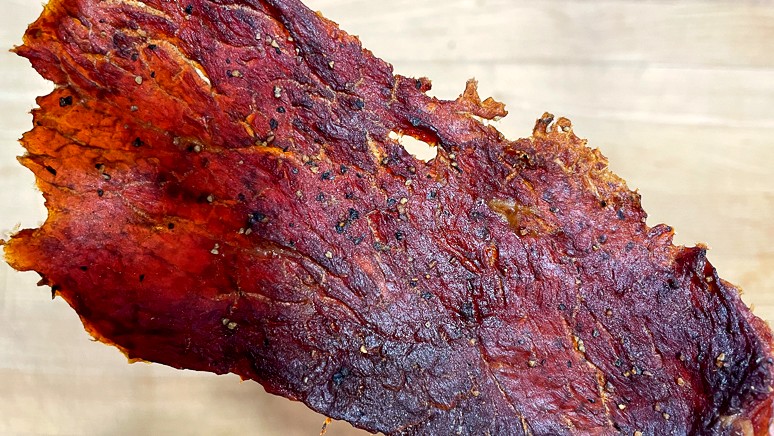Beef jerky is an easy and rewarding snack to make at home, especially when you have a dehydrator. A dehydrator helps maintain slow, even cooking at a constant temperature.
This recipe for flavorful beef jerky in a dehydrator features a robust medley of savory seasoning, bold soy sauce, and brown sugar sweetness for balance. You’ll be surprised by the great flavor with such simple ingredients.
There are two distinct advantages of a dehydrator when compared to a standard home oven when making homemade jerky.
First, a dehydrator operates at lower temperatures than most standard ovens. The dehydrator we use in our Test Kitchen, the Excalibur 9 Tray-Food Dehydrator (links to Amazon), starts at 105°F and goes up to 165°F. The traditional convection oven in our Test Kitchen only goes down to 200°F.* The lower temperature of a dehydrator allows for a longer, more even cook cycle.
*Some ovens do go lower in temperature and even have a dehydrate setting. Check your oven to see if you have these features.
Pro Tip: We recommend dehydrating beef jerky at a temperature of 165°F.
The second advantage of a dehydrator is extraction of moisture from the cooking environment. This allows the meat to dry as it cooks. Most home ovens operate in a sealed environment which traps moisture. A dehydrator circulates and extracts warm air.
While a dehydrator is the optimal cooking method for homemade beef jerky, it’s not essential. In fact, with a few tips and tricks, you can achieve delicious homemade beef jerky made right in your home oven. Check out our step-by-step guide on how to make beef jerky in an oven. You won’t be disappointed.
Do you have a smoker at home and love firing up the smoker? Check out our guide on how to make jerky in a smoker (coming soon).
Maybe you’re an air fryer aficionado. We have an air fryer beef jerky recipe as well (coming soon).
Our family has been making beef jerky for 90+ years and four generations. Our passion for cooking meat doesn’t stop at the end of the day. We love firing up new creations in our home kitchens. Commercial beef jerky might be our business, but homemade beef jerky is our passion.
We are honored to share our passion with you. Share your results with our team on our social media platforms (TikTok, Instagram, or Facebook).
Think of this recipe as a foundation for your homemade beef jerky creativity. You can easily turn this into a spicy beef jerky recipe with some dried chile peppers, hot sauce, or cayenne pepper.
Ready to take your jerky to the next level? Don’t forget to check out our very own beef jerky seasoning blends. We spent over a year and hundreds of batches to get the perfect blends. (Coming Soon! Sign-Up For Early Access).
Keep reading for pro tips, step-by-step instructions and frequently asked questions on how to make the best beef jerky in a dehydrator.
Step-By-Step Instructions to Make Beef Jerky in a Dehydrator
The process of making jerky breaks down into five easy steps, the sixth step being the best part – eating!
- Slice the Meat
- Mix the Marinade
- Marinate the Meat
- Lay the Jerky
- Dehydrate the Jerky
- Enjoy (and Store the Jerky)
1. Slice the Meat

Homemade beef jerky lends itself to creativity and exploration in the kitchen, but there are a few key features to look out for when shopping for meat for beef jerky.
- Lean meat (minimal to no fat)
- Economical (no need to break the bank)
- Fresh beef (avoid old or oxidized meat)
If you haven’t already selected your meat, explore our comprehensive guide on the best cuts of meat for beef jerky.
Pro Tip: Our personal recommendation for homemade beef jerky is Eye of Round. It’s economical, widely available, easy to work with, and packed with flavor.
Before we begin the slicing process, store your meat in the freezer for 30-60 minutes. Chilling down the meat will make slicing much easier.
The type of slices is all about personal preference—jerky slabs, jerky strips, jerky sticks—feel free to slice your meat to any shape. The most important thing to keep in mind is consistent thickness.
Select a thickness for the meat anywhere between 1/8” to 1/4” thickness. We prefer 3/18” for our homemade jerky. This range of thicknesses will result in a finished jerky with a slightly chewy and flavorful bite.
We prefer slicing against the grain for a tender beef jerky, but if you prefer a tougher beef jerky, feel free to slice with the grain.
Want more? Check out our detailed guide on how to slice meat for jerky.
Pro Tip: Don’t be afraid to ask your local butcher to slice your meat. A butcher has the proper tools to achieve near perfect uniformity, something even the most skilled butcher cannot perfectly replicate.
Looking to up your production and automate the slicing step? Check out our deep dive into the best jerky slicer options on the market.
2. Mix the Marinade
In a plastic bag or large mixing bowl, thoroughly mix all the wet and dry ingredients except for the meat. Make sure the sugar is fully dissolved in the jerky marinade.
3. Marinate the Meat

Add the meat to the marinade piece-by-piece. Massage with your hands or a large spoon until the meat is evenly coated.
Pro Tip: The sliced jerky meat can tangle and knot. This leaves some pieces unmarinated. Take your time to fully mix and massage the meat. The massaging step can also improve the texture of the final jerky.
Cover with plastic wrap and marinate the meat for at least 12 hours and up to 24 hours. The ideal marination time is 16 hours. Toss the meat a few times during the marination process to ensure proper contact between the meat and the jerky marinade.
This recommendation comes from extensive testing to find the optimal marination time for jerky. We tested every possible marination time to determine the sweet spot. Check out our detailed guide on how long to marinate the jerky.
4. Lay the Jerky

After the jerky has marinated for your desired time, you are ready to start the dehydration process.
Turn your dehydrator to 165°F.
Lay the beef strips onto each dehydrator tray. Pay attention to arrange the beef strips in one even layer with no overlapping pieces. The pieces can touch, but they should not overlap.
Pro Tip: Before arranging the jerky, let any excess marinade drip off the meat. This will prevent steaming of the marinated beef.
5. Dehydrate the Jerky

Dehydrate the meat for anywhere between 3 and 6 hours. The drying time ranges due to several factors: ambient temperature and humidity, thickness of the meat, marbling of the meat, and the cut of meat to name a few. There is not a single time and temperature combination, so this is where you will have to pay attention and use your senses.
Dehydrating jerky takes patience and a watchful eye.
At the three-hour mark, check the jerky for doneness. Check every 30 minutes until the desired doneness has been reached. Don’t be afraid to pull pieces that appear done and leave pieces that need more dehydration.
The jerky should have a dry, leathery exterior. We want to ensure the jerky bends, with some small cracks, but does not snap (in which case it’s over-dried). Think of bending a green branch.
Telling when beef jerky is done takes time and practice. Dive into our detailed guide on how to tell when jerky is done.
6. Enjoy and Store the Jerky

Boom. That’s it. Now it’s the best part – eat your amazing beef jerky.
Share with your friends and family, or keep the whole batch to yourself, we won’t judge.
Unlike store-bought beef jerky which can last much longer, properly dried jerky made at home will keep at room temperature in an airtight container for around one week. If you have any concerns on the dryness level, feel free to store in the refrigerator for extra safety.
Check out our detailed guide on how to store beef jerky.
Looking to upgrade your dehydrator or possibly purchase your first one? Check out our guide to Finding the Best Dehydrator for Jerky.
Don’t forget to check out our list of the 20+ Unique Beef Jerky Recipes.
This recipe is for whole-muscle beef jerky, but you can also dehydrate ground meat to make a delicious ground beef jerky.



